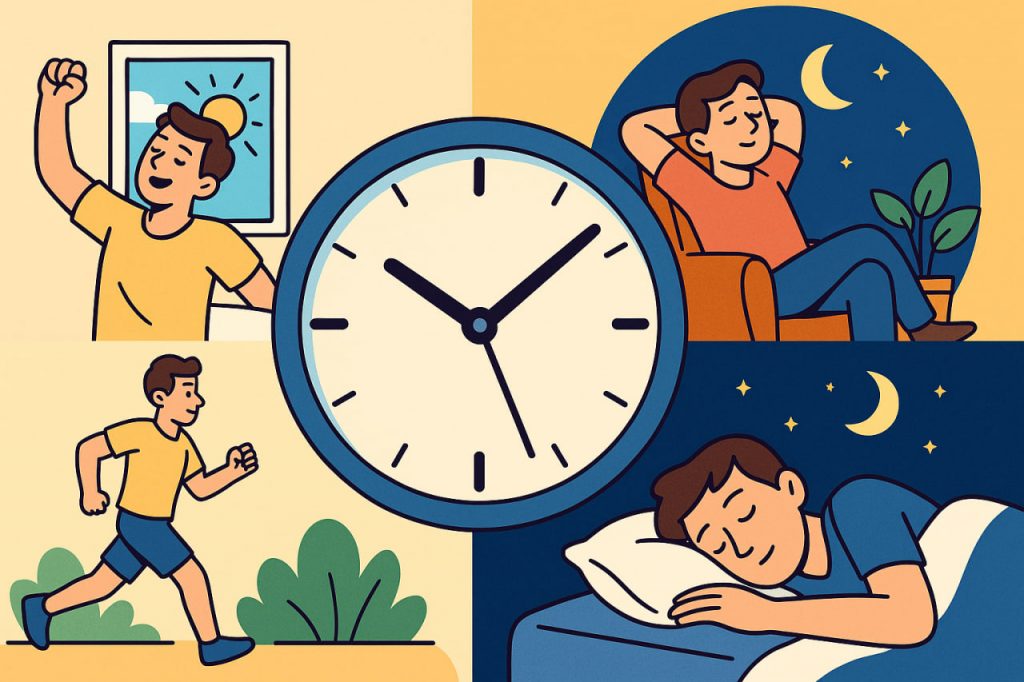Biological rhythms, also known as biorhythms, are natural, internal cycles that regulate the timing of physiological and behavioral processes. These rhythms help the body coordinate sleep, hormone release, digestion, and even body temperature. The most well-known biological rhythm is the circadian rhythm, which follows a roughly 24-hour cycle. Synchronizing daily activities with these rhythms improves overall health, enhances energy levels, and reduces the risk of chronic disease. Understanding how biorhythms function enables more effective planning of sleep, work, and nutrition.
Types of Biological Rhythms
There are several types of biorhythms classified by their cycle length. Circadian rhythms operate on a daily basis and regulate sleep-wake cycles, body temperature, and hormone production. Ultradian rhythms are shorter cycles (less than 24 hours), such as the stages of sleep or heart rate variability. Infradian rhythms last longer than 24 hours—examples include the menstrual cycle or seasonal mood patterns.
Each rhythm is governed by biological clocks located in different parts of the body, especially the suprachiasmatic nucleus (SCN) in the brain, which coordinates circadian timing. These clocks rely on both genetic programming and environmental cues like light and temperature.
The Role of Light and the Environment
Light is the most powerful external factor influencing biological rhythms, particularly the circadian cycle. When photoreceptors in the eyes detect daylight, they signal the SCN to regulate melatonin release and coordinate other hormonal systems. This process adjusts the body to the day–night cycle.
Exposure to natural morning light supports wakefulness and mental alertness. In contrast, exposure to artificial light at night, especially blue light from screens, disrupts melatonin secretion and interferes with sleep. Environmental factors such as noise, temperature, and social routines also contribute to rhythm stability.
Health Implications of Disrupted Rhythms
Misalignment of biological rhythms can lead to serious health consequences. Disrupted sleep-wake cycles, such as those caused by shift work, jet lag, or chronic insomnia, interfere with metabolic processes, weaken the immune system, and increase the risk of cardiovascular diseases and depression.
Even irregular eating times or skipping meals can disturb digestive biorhythms, leading to insulin resistance, weight gain, and digestive disorders. Mental clarity, mood stability, and hormone balance also suffer when natural cycles are ignored or overridden by external demands.
How to Align Daily Life With Biorhythms
Maintaining alignment with biological rhythms requires consistent routines and attention to environmental cues. Going to bed and waking up at the same time daily supports the circadian system. Prioritizing morning light exposure and reducing screen time in the evening helps maintain healthy melatonin rhythms.
Meal timing is also important. Eating meals at regular intervals, especially a balanced breakfast, reinforces metabolic patterns. Incorporating physical activity during natural energy peaks—usually mid-morning or early evening—can enhance performance and recovery.
Chronotypes and Individual Differences
Not all people have identical biological timing. Chronotypes describe individual preferences for activity at certain times of the day. Some people are naturally inclined to wake early and are most alert in the morning (morning types), while others are more energetic later in the day (evening types).
These differences are partly genetic and partly influenced by age, lifestyle, and environment. Understanding one’s chronotype can improve sleep quality, productivity, and emotional balance. Tailoring schedules to match internal rhythms, where possible, leads to better long-term health outcomes.
Conclusion
Biological rhythms are fundamental to human health and function. They shape how we sleep, eat, think, and feel. Aligning daily routines with these internal cycles enhances energy, improves mood, and supports vital systems such as immunity and metabolism. As modern life becomes more demanding and erratic, maintaining respect for the body’s natural timing becomes even more essential.
Glossary
- Biological rhythms (biorhythms) — recurring internal processes that regulate physical and behavioral functions.
- Circadian rhythm — a 24-hour biological cycle governing sleep, wakefulness, and hormonal activity.
- Suprachiasmatic nucleus (SCN) — a brain structure that acts as the master clock for circadian rhythms.
- Melatonin — a hormone released in darkness that regulates sleep timing.
- Chronotype — an individual’s natural preference for morning or evening activity.
- Ultradian rhythm — biological cycles shorter than 24 hours.
- Infradian rhythm — biological cycles longer than 24 hours.
- Photoreceptors — light-sensitive cells in the eyes that influence circadian regulation.


